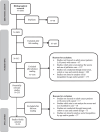Age- and gender-based social inequalities in palliative care for cancer patients: a systematic literature review
- PMID: 39296836
- PMCID: PMC11408182
- DOI: 10.3389/fpubh.2024.1421940
Age- and gender-based social inequalities in palliative care for cancer patients: a systematic literature review
Abstract
Objectives: Cancer is a major public health problem worldwide, given its magnitude and growing burden, in addition to the repercussions on health and quality of life. Palliative care can play an important role improving quality of life and it is cost-effective, but some population groups may not benefit from it or benefit less based on age and gender inequalities. The aim of this systematic review was to analyze the available evidence on age- and gender-based social inequalities in access to and use of palliative care in cancer patients.
Methods: A systematic review was conducted following the PRISMA guidelines. An exhaustive literature research was performed in Pubmed, CINHAL and Embase until November 2022 and were not restricted by language or date of publication. Eligible studies were observational studies analyzing the access and use of palliative care in cancer patients.
Results: Fifty-three studies were included in the review. Forty-five analyzed age and 44 analyzed gender inequalities in relation to use of and access to palliative care. Our results show that older people receive poorer quality of care, worst symptom control and less preferences for palliative care. In relation to gender, women have a greater preference for the use of palliative care and generally have more access to basic and specialized palliative care services and palliative care facilities.
Conclusion: This review reveals difficulties for older persons and men for access to key elements of palliative care and highlights the need to tackle access barriers for the most vulnerable population groups. Innovative collaborative services based around patient, family and wider community are needed to ensure optimal care.
Keywords: age; gender; hospice and palliative care; palliative care; review – systematic.
Copyright © 2024 Rodríguez-Gómez, Pastor-Moreno, Ruiz-Pérez, Escribà-Agüir and Benítez-Hidalgo.
Conflict of interest statement
The authors declare that the research was conducted in the absence of any commercial or financial relationships that could be construed as a potential conflict of interest.
Similar articles
-
Palliative care experiences of adult cancer patients from ethnocultural groups: a qualitative systematic review protocol.JBI Database System Rev Implement Rep. 2015 Jan;13(1):99-111. doi: 10.11124/jbisrir-2015-1809. JBI Database System Rev Implement Rep. 2015. PMID: 26447011
-
A population-based study of age inequalities in access to palliative care among cancer patients.Med Care. 2008 Dec;46(12):1203-11. doi: 10.1097/MLR.0b013e31817d931d. Med Care. 2008. PMID: 19300309 Free PMC article.
-
Ethnic inequalities in palliative care prescribing in high income countries - a rapid systematic review.BMC Palliat Care. 2025 Apr 26;24(1):119. doi: 10.1186/s12904-025-01742-1. BMC Palliat Care. 2025. PMID: 40287652 Free PMC article.
-
Palliative versus hospice care in patients with cancer: a systematic review.BMJ Support Palliat Care. 2021 Jun;11(2):188-199. doi: 10.1136/bmjspcare-2020-002195. Epub 2020 Jul 17. BMJ Support Palliat Care. 2021. PMID: 32680891
-
Inequity in palliative care service full utilisation among patients with advanced cancer: a retrospective Cohort study.Acta Oncol. 2020 Jun;59(6):620-627. doi: 10.1080/0284186X.2020.1736335. Epub 2020 Mar 9. Acta Oncol. 2020. PMID: 32148138
Cited by
-
Sex and gender in palliative and end-of-life care: A service evaluation and qualitative analysis.Palliat Care Soc Pract. 2025 Jul 29;19:26323524251344310. doi: 10.1177/26323524251344310. eCollection 2025. Palliat Care Soc Pract. 2025. PMID: 40756471 Free PMC article.
-
Patients potentially in need for palliative care in Germany-A regional small-area estimation based on death registry data.Res Health Serv Reg. 2025 Jul 11;4(1):8. doi: 10.1007/s43999-025-00070-4. Res Health Serv Reg. 2025. PMID: 40643778 Free PMC article.
-
Patients' Preferences for Gastric Cancer Treatment: A Cross-Sectional Study on Decision-Making in Multidisciplinary Treatment Strategies.J Gastric Cancer. 2025 Jul;25(3):478-496. doi: 10.5230/jgc.2025.25.e35. J Gastric Cancer. 2025. PMID: 40631476 Free PMC article.
References
-
- Ervik M, Lam F, Laversanne M, Ferlay J, Bray F. Global Cancer observatory: Cancer over time. Lyon, France: International Agency for Research on Cancer; (2021).
Publication types
MeSH terms
LinkOut - more resources
Full Text Sources
Medical


